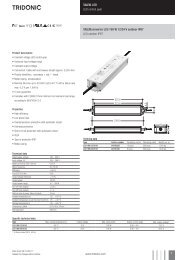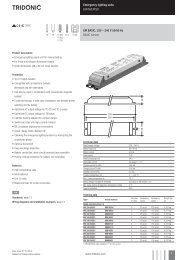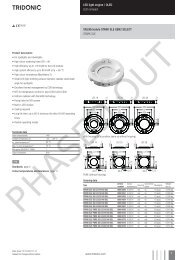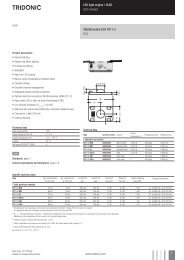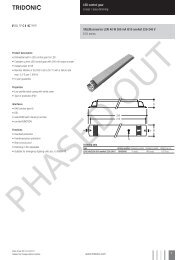Tengine STARK SLE PREMIUM
Tengine STARK SLE PREMIUM
Tengine STARK SLE PREMIUM
You also want an ePaper? Increase the reach of your titles
YUMPU automatically turns print PDFs into web optimized ePapers that Google loves.
  Optical Aspects<br />
Eye safety<br />
Risk group<br />
Actinic UV E (200 - 400 nm)<br />
S<br />
Near UV E (315 - 400 nm)<br />
UVA<br />
Blue light L (300 - 700 nm)<br />
B<br />
Retina, thermal L (380 - 1,400<br />
R<br />
nm)<br />
IR radiation, eye E (780 -<br />
IR<br />
3,000 nm)<br />
Evaluation<br />
Risk group 0*<br />
Risk group 0*<br />
Risk group 0*<br />
Risk group 0*<br />
Risk group 0*<br />
* The evaluation of eye safety is based on EN 62471:2008 (photo-biological safety of lamps and lamp systems):<br />
Risk-free (risk groups 0, 1, 2 and 3): The LEDs do not pose any photo-biological risk.<br />
Low risk: The LEDs pose a small risk because of normal limitations.<br />
Medium risk: The LEDs pose a small risk because of reactions to bright light sources or thermal discomfort.<br />
High risk: The LEDs pose a risk even with just momentary or temporary exposure.<br />
Reflector design and beam characteristics<br />
Reflektor design<br />
The mechanical and optical properties of the modules of the TALEXXengine <strong>STARK</strong> <strong>SLE</strong> <strong>PREMIUM</strong> system offer the best<br />
conditions for using reflectors. The overall efficiency of the system can be optimised by choosing a reflector that directs the<br />
light appropriately.<br />
The optical properties (e.g. beam angle) and the dimensions of the reflector play a crucial role.<br />
The overall height of the luminaire can be reduced by selecting a low-profile reflector, depending on the beam angle required.<br />
This may improve the thermal output of the luminaire by increasing the height available for the heat sink.<br />
To achieve uniform illumination a reflector withy an integrated diffuser is recommended for LED modules with multicolour<br />
LEDs. This ensures that the colours are properly mixed. Some reflectors have the option of faceting for the reflector wall.<br />
Depending on the position of the homogenising element, different efficiencies and different colour mixing results can be<br />
achieved.<br />
Technical Design-in Guide TALEXXengine <strong>STARK</strong> <strong>SLE</strong> <strong>PREMIUM</strong> | 11-2012 | en - 31 / 50 -



